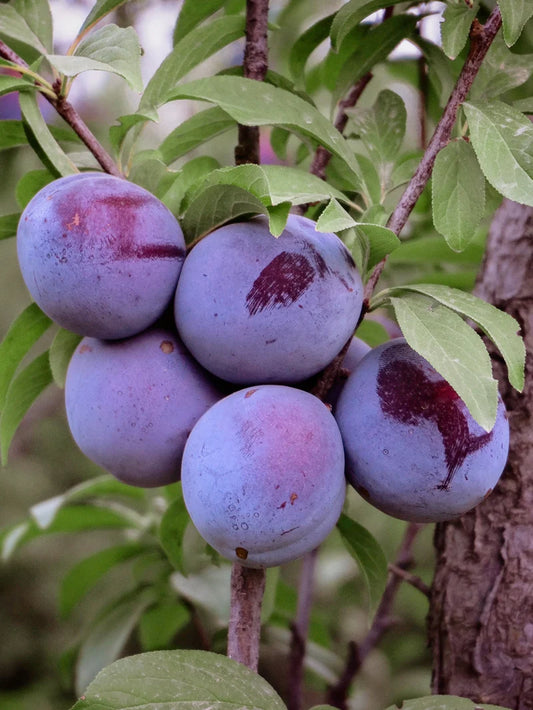

Directions for Planting and Care
Planting and caring for your Morris Plum Tree is a simple process that ensures a healthy tree and an abundant harvest. Follow these steps to help your tree thrive.
Planting
Select the Right Location: Choose a spot in your garden that receives full sun. Morris plum trees require at least six to eight hours of direct sunlight daily for optimal growth and fruit production. Ensure there is enough space for the tree to spread, allowing proper air circulation to prevent disease.
Prepare the Soil: The soil should be well-draining and rich in organic matter. If your soil is heavy or clay-like, mix in compost or organic material to improve drainage and soil structure. A slightly acidic to neutral soil pH (around 6.0–7.0) is ideal for healthy root development.
Dig a Proper Hole: Dig a hole that is twice as wide as the root ball and approximately the same depth. This will allow the roots to spread freely and establish themselves more easily.
Plant the Tree: Carefully remove the Morris plum tree from its container and loosen the roots slightly with your hands before placing it in the hole. Position the tree so that the top of the root ball is level with the ground. Backfill with soil, gently pressing down to remove any air pockets.
Water Thoroughly: After planting, water the tree deeply to help settle the soil and ensure that the roots receive adequate moisture. Continue watering regularly, especially during the first year after planting, to support root establishment.
Care
Regular Watering: Morris plum trees require consistent watering, particularly during dry spells and in the first few years of growth. Water deeply and regularly to keep the soil evenly moist but not waterlogged. Established trees are more drought-tolerant but still benefit from supplemental watering during extended dry periods.
Pruning: Prune the Morris plum tree in late winter while the tree is dormant. Remove any dead, damaged, or overcrowded branches to encourage better air circulation and sunlight penetration. Regular pruning also helps maintain the tree’s shape and promotes healthy fruit production. Additionally, remove any suckers that grow from the base of the tree to direct energy toward fruiting branches.
Thinning Fruit: To ensure larger and healthier plums, thin the fruit in early May and again in July. Remove any damaged or diseased plums first, then thin the remaining fruit so that they are spaced about 3–4 inches apart. This prevents overloading of the branches, which can lead to breakage and reduced fruit quality.
Fertilization: Apply a balanced, slow-release fertilizer in early spring to provide essential nutrients for healthy growth and fruit development. Avoid excessive nitrogen fertilizers, as they can lead to excessive leaf growth at the expense of fruit production.
Morris plum trees are known for their juicy, red-skinned fruit with sweet, flavorful flesh. With proper planting and care, your tree will provide you with an abundant harvest for many years to come, making it a valuable addition to any home orchard.
Frequently Asked Questions
What are the main characteristics of the Morris Plum Tree?
When does the Morris Plum Tree bear fruit?
How should the Morris Plum Tree be planted for optimal growth?
What are the best uses for Morris Plums?
What our customers say
Real reviews from real customers
People Also Bought
Here’s some of our most similar products people are buying. Click to discover trending style.
Recently Viewed
Don't forget! The products that you viewed. Add it to cart now.



